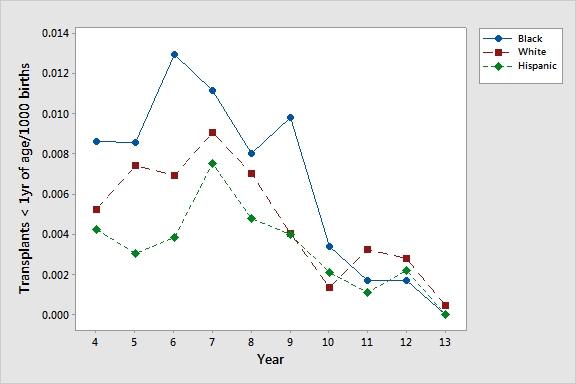Racial Differences Amongst Infants Undergoing Intestine Transplants.
Transplant Institute, MedStar Geogetown University Hospital, Washington, DC.
Meeting: 2016 American Transplant Congress
Abstract number: C61
Keywords: Pediatric
Session Information
Session Name: Poster Session C: Economics, Public Policy, Allocation, Ethics
Session Type: Poster Session
Date: Monday, June 13, 2016
Session Time: 6:00pm-7:00pm
 Presentation Time: 6:00pm-7:00pm
Presentation Time: 6:00pm-7:00pm
Location: Halls C&D
Background
It is known that the demographics of the United States are changing because of immigration and increased birth rates in non-white populations. Here we examine whether there is a racial component in the trend intestine transplantation in children.
Method
We reviewed data from the United Network of Organ Sharing (UNOS) database and the U.S. federal government national birth data. As per these databases racial groups were as follows: “White”, “Black”, “Hispanic” and for this analysis, “Asian” and “Other” did not represent a large enough number so were categorized under' “Other”. Data was analyzed from 2004 to 2014 (11 years). MINITAB software, (Minitab Inc. State College, PA) was used to analyze data. As per UNOS patients were grouped in the following age ranges in years: <1, 1-5, 6-10, and 11-17.
Results
A total of 817 transplants that included an intestine were performed in children aged up to 18 years of age during the study period. The majority where White (n=449) or less commonly Black (n= 170), Hispanic (n= 152) or Other (n= 46). The majority of transplants were either <1 year, or 1-5 years. The greatest change for number of annual transplants was in the White, infant group which achieved a maximal annual transplant rate in 2006 and dropping by 85% since then. However as a proportion of the total births in the United States the group of Black infants had the highest transplant rate 2.7/100,000 versus White 1.9/100,000 (p<0.05) and Hispanic individuals 1.5/100,000 (p<0.05). The biggest decrease in the number of transplants of infants as a proportion of the total births was also the greatest in the Black group [figure 1]. Up to and including 2013, the birth rates for the United States were overall stable throughout the decade.

Conclusion
There is a trend towards a reduction in infants undergoing intestine transplant and while the absolute reduction is greatest White newborns, newborns in the black category have shown the greatest drop as a proportion of births. These changes are not explained by changes in the demographics in the United States birth population.
CITATION INFORMATION: Khan K, Desai C, Kaufman S, Girlanda R, Hawksworth J, Kroemer A, Fishbein T, Matsumoto C. Racial Differences Amongst Infants Undergoing Intestine Transplants. Am J Transplant. 2016;16 (suppl 3).
To cite this abstract in AMA style:
Khan K, Desai C, Kaufman S, Girlanda R, Hawksworth J, Kroemer A, Fishbein T, Matsumoto C. Racial Differences Amongst Infants Undergoing Intestine Transplants. [abstract]. Am J Transplant. 2016; 16 (suppl 3). https://atcmeetingabstracts.com/abstract/racial-differences-amongst-infants-undergoing-intestine-transplants/. Accessed December 27, 2025.« Back to 2016 American Transplant Congress
